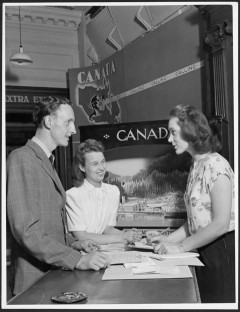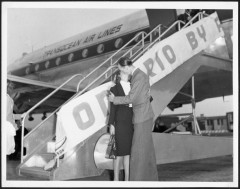We’re delighted to announce the recent publication of Invisible Immigrants: The English in Canada since 1945 (March 2015) by Carleton’s Marilyn Barber and Murray Watson (Dundee University, Scotland) by University of Manitoba Press.

“Jim, a newly arrived English immigrant, will not lose weight with Mrs. Beattie’s cooking” [1947] (Archives of Ontario, RG 9-7-4-2-21)
About Invisible Immigrants
The book documents the experiences of English-born immigrants who chose to come to Canada during England’s last major wave of emigration between 1947 and the mid 1970s. For some years the largest immigrant group contributing to the development of postwar Canada, these English migrants nonetheless have remained almost invisible in Canadian history. Most were in their twenties or early thirties -young couples or single women and men – and settled in urban areas, with Ontario being the most popular destination. Life story oral histories reveal the personal nature of the migration experience along with the complex intertwining of motivations that brought English migrants to Canada and the process of adaptation that led to their accepting Canada as home.
Marilyn Barber and Murray Watson want to thank the postwar English migrants who so willingly shared their life stories through oral interviews. Those interviewed originally settled from Halifax on the east coast to Vancouver Island on the west coast although most first came to Ontario or the Montreal area of the province of Quebec. The interviewees communicated their memories of a life lived between two countries and two continents perceptively, with humour and sometimes with tears, with a sense of achievement or occasionally of frustration with unexpected barriers, and with interesting insights into society in the postwar era, their younger selves, and their evolving sense of belonging and identity. In recognition of the importance of this community involvement in the research for the book, as well as the continuing public significance of immigration for Canada, the authors have striven to write Invisible Immigrants in a style that is accessible and, they hope, engaging for general readers interested in Canadian history. At the same time, the book contributes to the academic study of Canadian immigration, oral, and gender history.
